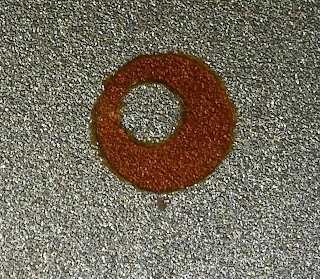They are Hall effect isolated current to voltage converters that I plan to use to measure stepper motor current waveforms in conjunction with an oscilloscope. They don't have any mounting holes, so I clamped them by the corners and screwed them onto a printed base.
I wanted the base to be heavy to stop them being dragged around by the scope leads. A while ago I saw a Youtube video by Warner Berry where he used lead shot to make printed parts with heavy bases. He prints parts with no bottom layers, so the honeycomb infill is exposed. He fills that with lead shot and then pours in epoxy resin. When that has cured he sands the base flat and sticks on a rubber sheet to make them non-slip.
I found lead shot on eBay sold for filling diving belts but I also found steel shot sold for filling teddy bears and that was much cheaper and available in smaller diameters. Steel has about 2/3 the density of lead, so it is a cheaper way of adding weight if you can accommodate 50% more volume. It also has the advantage of being non-toxic of course.
I got the smallest size, which is 1mm balls, on the basis that they will fill a space slightly better than larger sizes. The downside I found was that when pouring them they tend to bounce and fly all over the place. They don't vacuum up because they have a very high weight to air resistance ratio being spherical. I had to use a magnet to capture them. In hindsight I think 2mm balls would be easier to handle.
Instead of printing infill without bottom layers I simply made the whole base hollow. It doesn't need any infill for strength because it is going to be filled with resin. It is quite a large area to bridge without infill but it gets covered, so it doesn't matter how ugly it prints.
The screws go into brass heat fit inserts that I press in with a soldering iron. In hindsight I should have capped the holes to prevent resin getting in them.
After I filled it with the steel shot I poured in two part polyurethane resin that I had left over from an experiment nearly 10 years ago:hydraraptor.blogspot.co.uk/2008/03/hdpe-pu. I was amazed it still worked. It is probably better for this application than epoxy resin because it is less viscous, so should fill the gaps more easily.
Here it is after I sanded it down: -
Not the best casting as I under filled one corner and there are some bubbles, but it doesn't matter at all in this application.
I covered it with a sheet of adhesive backed neoprene rubber. It is probably not the best choice of rubber because it seems to be quite slippery.
The end result weighs 80g which feels quite heavy for something this size and is just about heavy enough to not be dragged around by scope leads. If I was making it again I would make it a bit deeper and try to find a better non-slip rubber.
Another way to encapsulate the shot would be to pause the print and pour them in before before the top layers are printed. They would then rattle of course, which might be annoying. On a moving bed machine like Mendel90 there would be a limit to how much weight you could add without lowering the acceleration. Also adding weight might cause the bed to drop in level slightly giving an uneven layer. Neither would be problems on HydraRaptor because its moving table weighs 9kg and has a load capacity of 125kg!














